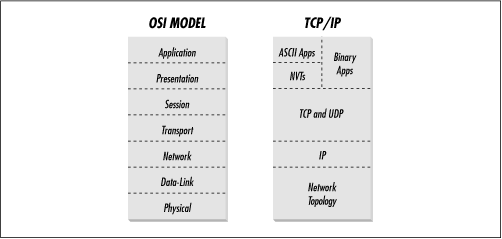Comparing TCP/IP to the OSI Reference Model
TCP/IP does not strictly conform to the OSI Reference Model. Some portions of the OSI Reference Model map directly to some of the protocols and services provided by TCP/IP, while many of the layers do not map to each other directly at all. For example, the actual delivery of data over the network is handled at the physical layer, and in this case, the wire is the physical layer. There are no services in TCP/IP that correspond with the physical or data-link layers. Rather, IP passes data to a network adapter’s device driver, which provides an interface to the data-link layer in use with the physical layer.
Figure 1.4 shows how TCP/IP matches up with the OSI Reference Model. Notice that TCP/IP does not provide any physical or data-link layer services directly, but instead relies on the local operating system for those services.

The specific layers offered by TCP/IP include:
- The Internet Protocol
-
IP itself works at the network layer of the OSI reference model. It is responsible for tracking the addresses of devices on the network, determining how IP datagrams are to be delivered, and sending IP packets from one host to another across a specific segment. In essence, IP provides a virtual representation of the network that is independent of any of the individual network ...
Get Internet Core Protocols: The Definitive Guide now with the O’Reilly learning platform.
O’Reilly members experience books, live events, courses curated by job role, and more from O’Reilly and nearly 200 top publishers.

